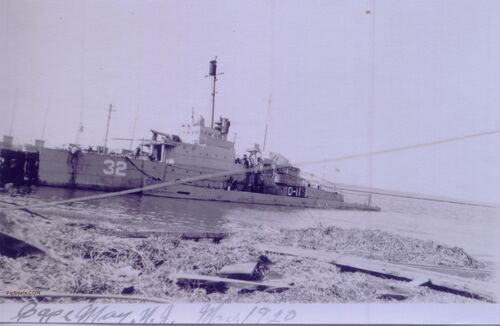O-11: Difference between revisions
Pbcjohnston (talk | contribs) Added captions |
Pbcjohnston (talk | contribs) mNo edit summary |
||
| Line 11: | Line 11: | ||
O-11 is seen here moored outboard of the patrol vessel USS Eagle No. 32. The photo was taken in March, 1920 at Cape May, New Jersey. The Navy maintained a base there during WW I and WW II before it became a major Coast Guard facility. | O-11 is seen here moored outboard of the patrol vessel USS Eagle No. 32. The photo was taken in March, 1920 at Cape May, New Jersey. The Navy maintained a base there during WW I and WW II before it became a major Coast Guard facility. | ||
The O-11 has just completed a period of yard work done at the Philadelphia Navy Yard prior to her deployment to Coco Solo to join the submarines based there. The Eagle No. 32 was commissioned on September 4, 1919, too late for WW I. She is only seven months old in this photo. The Eagle-class vessels were mass produced by Henry Ford at a plant that was hastily built on the River Rouge near Detroit. Ford had been personally appointed to build these vessels by the | The O-11 has just completed a period of yard work done at the Philadelphia Navy Yard prior to her deployment to Coco Solo to join the submarines based there. The Eagle No. 32 was commissioned on September 4, 1919, too late for WW I. She is only seven months old in this photo. The Eagle-class vessels were mass produced by Henry Ford at a plant that was hastily built on the River Rouge near Detroit. Ford had been personally appointed to build these vessels by the United States Shipping Board to address the threat posed by the German U-boats. The design was deliberately kept very simple, eliminating as many curves as possible to facilitate construction by workers normally employed to build automobiles. The result was an ugly, slab-sided, leaky vessel that was a poor sea-boat, but was very utilitarian. In the end they got the job done, with several of them serving to the end of WWII. | ||
<small>Photo in the private collection of George Petersen, grandson of George Petersen who took the photo. Used with permission.</small> | <small>Photo in the private collection of George Petersen, grandson of George Petersen who took the photo. Used with permission.</small> | ||
Revision as of 15:13, 8 October 2023

Photo NH 44557 courtesy of NHHC.

O-11 is seen here moored outboard of the patrol vessel USS Eagle No. 32. The photo was taken in March, 1920 at Cape May, New Jersey. The Navy maintained a base there during WW I and WW II before it became a major Coast Guard facility.
The O-11 has just completed a period of yard work done at the Philadelphia Navy Yard prior to her deployment to Coco Solo to join the submarines based there. The Eagle No. 32 was commissioned on September 4, 1919, too late for WW I. She is only seven months old in this photo. The Eagle-class vessels were mass produced by Henry Ford at a plant that was hastily built on the River Rouge near Detroit. Ford had been personally appointed to build these vessels by the United States Shipping Board to address the threat posed by the German U-boats. The design was deliberately kept very simple, eliminating as many curves as possible to facilitate construction by workers normally employed to build automobiles. The result was an ugly, slab-sided, leaky vessel that was a poor sea-boat, but was very utilitarian. In the end they got the job done, with several of them serving to the end of WWII.
Photo in the private collection of George Petersen, grandson of George Petersen who took the photo. Used with permission.
Page created by:
Ric Hedman & David Johnston
1999 - 2023 - PigBoats.COM©
Mountlake Terrace, WA, Norfolk, VA
webmaster at pigboats dot com
